Review: Korg opsix
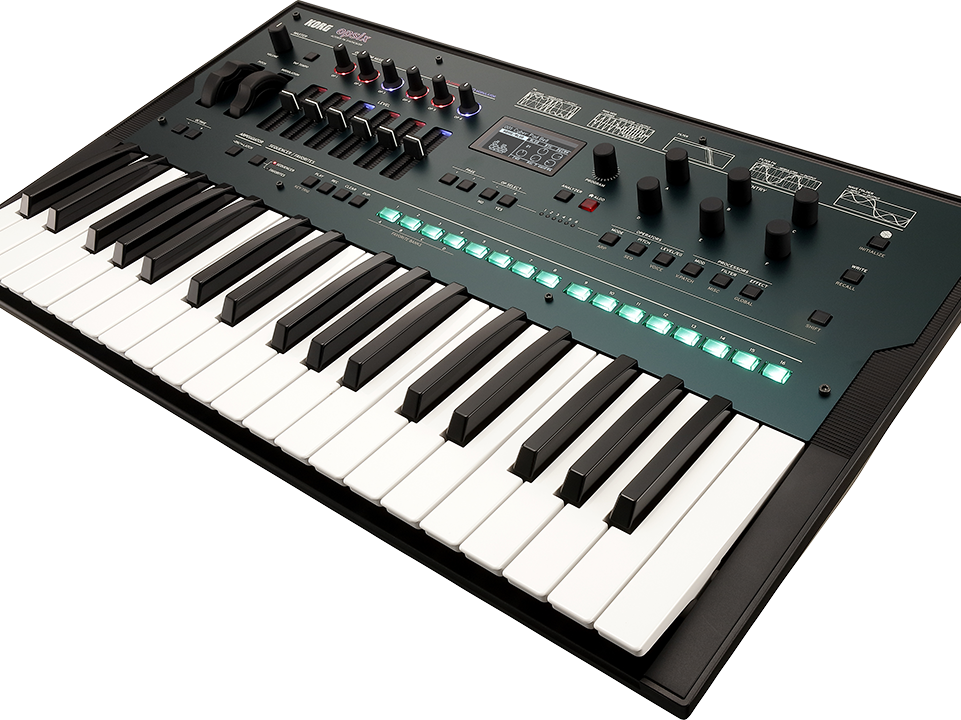
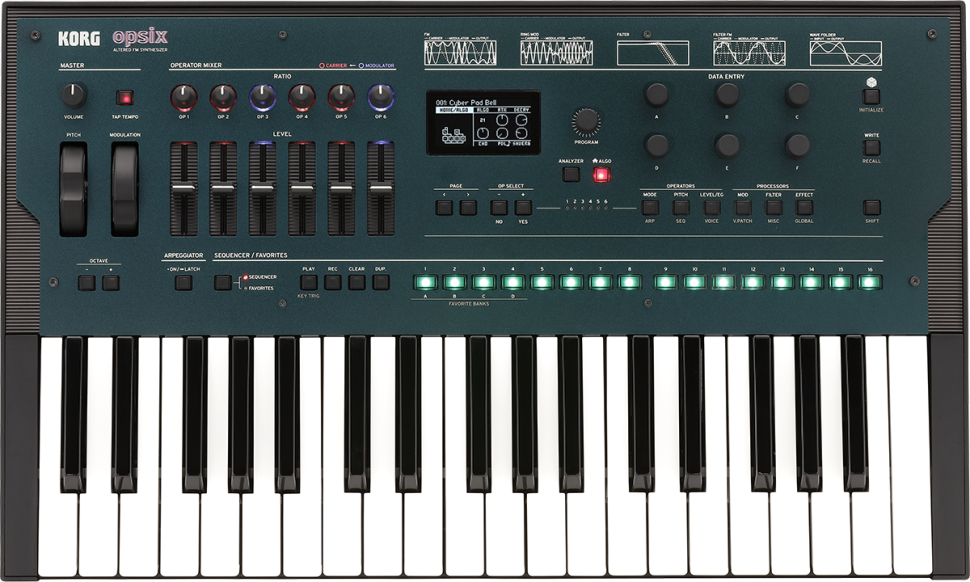
Revival of FM synthesis
In recent years, however, a renaissance of FM synthesis is emerging. This is because many modern music styles demand punchy, cutting and hard digital sounds, as well as 80s revival sounds that only an FM synthesizer can really pull off convincingly. Yamaha has Reface DX as well as Montage and MODX on offer, and with FM-X, they rely on an even more complex sound generator. Elektron packs FM synthesis into the compact Digitone groovebox, and smaller boutique manufacturers serve the experimental market with PreenFM or MEGAfm.
Direct access
Korg pursues a similar approach with the opsix like with the DS8 and starts with the biggest shortcoming of the forefather DX7: the complicated operation. Direct access to the frequencies and volumes of all 6 oscillators or operators, as well as a downstream subtractive synthesis with emulations of analog filters, are supposed to facilitate the entry into the potent sound generation; the built-in step sequencer with parameter recording provides movement and a multi-effect is built in for refinement.
Hardware only on a Wavestate level
The hardware is strongly reminiscent of the Korg Wavestate. This doesn‘t have to be a bad thing in principle, because costs can be saved by taking over elements of other synthesizers. Modal shows this in an extreme form, because the Cobalt8 sits in exactly the same case as the Argon8. Although the Cobalt8 comes from a small company, its hardware impresses with a robust metal housing and an outstandingly playable Fatar keyboard with aftertouch. The opsix looks much cheaper and more toy-like in direct comparison, although it is over 100 Euros more expensive than the Cobalt. You can expect more from a big company like Korg.
Clunky keyboard without aftertouch
The velocity sensitive keyboard is familiar from the Wavestate. It is only of average quality; too smooth and too loud, and the lack of aftertouch is incomprehensible for dynamic sound synthesis like FM. The plastic case with upper metal plate also doesn‘t look very high quality. We can only hope that Korg will release a large version with a decent keyboard or a desktop version like the Minilogue.
The two wheels for modulation and pitch bend are located above the keyboard, which keeps the opsix compact and, thanks to the light weight of the plastic case, also easy to transport. However, battery operation for mobile use is not provided.
Connections reduced to the essentials
All connections are on the back and are quickly dealt with. The opsix is only monotimbral, so it can only produce one sound at a time and not several (even if at least a kind of split sound can be programmed with the FM synthesis). Therefore, single outputs could be omitted, audio signals reach the outside world via two balanced jack sockets and a headphone jack. MIDI data is received and sent via USB or two DIN jacks (IN/OUT), USB audio was not integrated. An audio input is also missing, which is a pity considering the good filters and effects.
There is only one connection for a damper pedal. If aftertouch is omitted, Korg could have at least integrated a connector for an expression pedal; however, keyboardists can use a decent external keyboard with aftertouch and additional controller connections, anyway. The power is supplied via an external power supply.
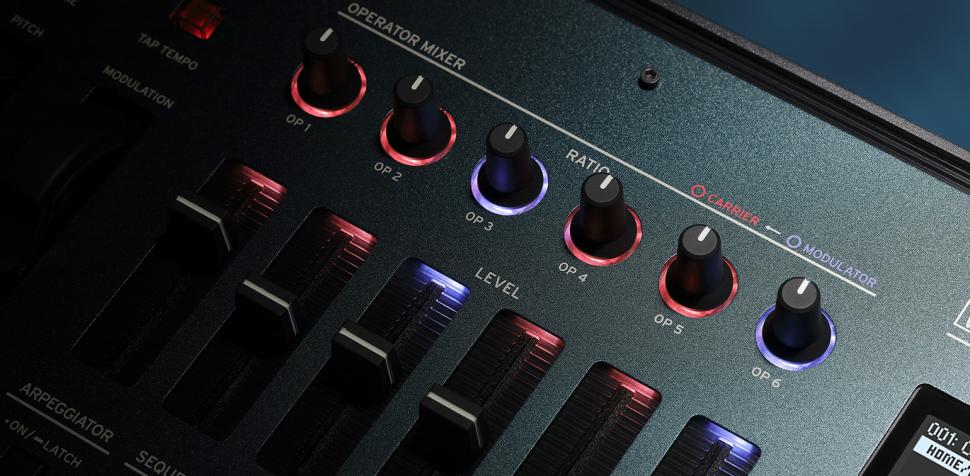
Knobs and faders for each OP
On the other hand, the very lush features of the controls for an FM synthesizer are pleasing. In the upper left corner there are six faders and endless knobs. These are used to control the volume and frequency spacing of the individual oscillators. The faders and knobs are illuminated and their colors indicate whether the respective oscillator is used as a carrier or modulator. Reminder: Depending on the linkage, an oscillator (called operator in FM) can either be heard (=carrier), or it serves in the background for frequency modulation of a carrier (=modulator). For example, Operator 1 and 3 can be sent directly to the audio output, while Operator 2 modulates Operator 1 and Operator 4 acts on Operator 3 and is, itself, influenced by Operators 5 and 6. In addition, there is a feedback loop that allows an operator to modulate itself. Sounds complicated? It is, and it takes some experience to use FM to create the sound you want.
Advanced FM Synthesis
The sound synthesis in the opsix goes way beyond the DX7 and offers more waveforms per oscillator than just sine and also allows more combinations. 40 algorithms plus individual operator circuitry are available. The volumes of the modulators, which have a different effect than in analog synthesizers, are essential for their sonic results. If you modulate the volume of Operator 2 via an envelope in the example above, the modulation of Operator 1 follows this course. This is more reminiscent of a filter envelope than a volume envelope, since Operator 2 is not audible as a modulator. The same applies to the frequency ratio between carrier and operator. It decides between bell and bass, harmonic piano sound or disharmonic metal thunderstorm. And this complex interaction can be „grasped“ directly with the opsix in the double sense of the word, because you have direct access to these parameters for all six operators.
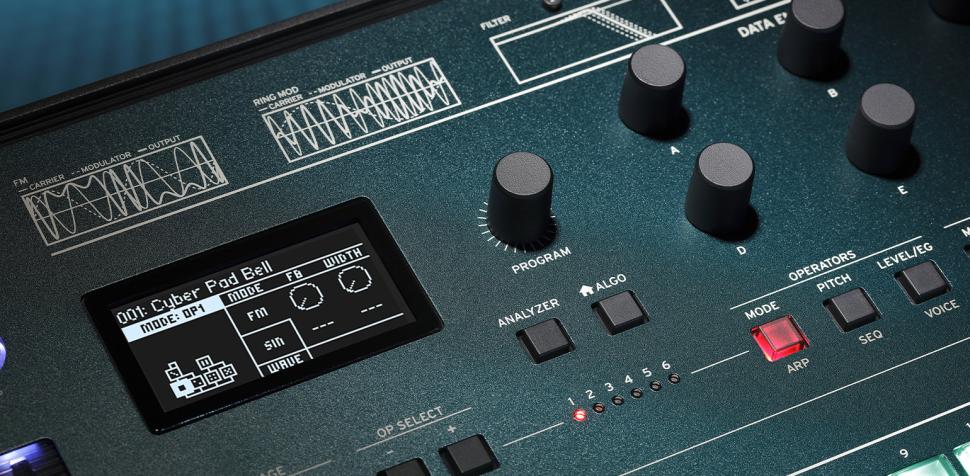
No macro controls
The fader/encoder combination is complemented by six additional knobs on the right side, which fulfill various functions. Among other things, you can use them to edit the volume and pitch curves, switch between the menu sections and the individual operators with the buttons below them; and the central OLED display shows the current parameter assignment of the knobs. Here, unfortunately, the operation becomes a bit more menu-heavy and fiddly, but this is more the fault of the complex possibilities of FM synthesis than Korg. Nevertheless, from our point of view, it would have made sense to give the opsix a few macro knobs to set parameters like attack and decay of the envelopes for all modulators or all carriers together, like on the Volca FM. At least a selection of several operators for joint editing (like with the RefaceDX controller from Dtronics) would be a relief. Perhaps this can still be upgraded via firmware update.
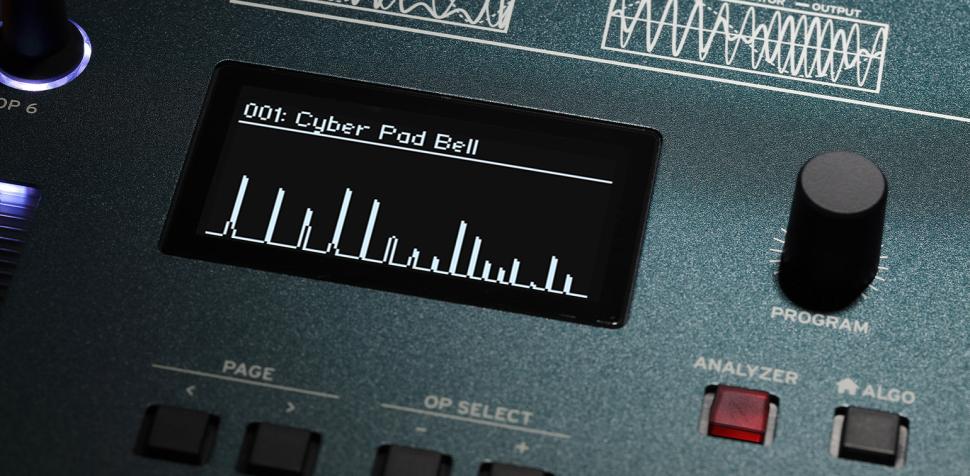
Additional digital synthesis
As already indicated, Korg does not rely on FM synthesis alone for the opsix, but has built in numerous other features. Not only can one of the 21 available waveforms (sine, sawtooth, square, and more) be selected for each individual operator, but alternative synthesis can even be set. Instead of frequency, volume can be modulated, resulting in a high-speed tremolo and thus a similar but different sound coloration compared to typical FM. FilterFM allows the modulation of the cutoff frequency in the audio range. This effect provides rough, metallic and overtone-rich sounds depending on the resonance value. Wavefolder „folds“ the waveform resulting in aggressive and distorted sounds. And if you prefer virtual-analog, you can do without digital modulation and choose the pure filter engine to send the unaltered waveforms through the great-sounding filter emulations. A widely configurable random function helps to create your own sounds even without a deeper understanding of sound generation.
Virtual analog filter
The signal of the sound generators runs through a virtual analog filter. Eleven different filter types are available, including the legendary MS-20 filter for dirty sounds with character and the Polysix filter for beautifully smooth pads and leads. Those familiar with the corresponding plug-ins know that Korg‘s digital recreations of analog filters can sound quite convincing. And Yamaha has already shown with the DX200 groovebox that a downstream filter is useful for taming the harmonic orgies of digital audio modulation.
Modulation variety and effects
The modulation sources have not been spared either; in addition to three envelopes and four flexible LFOs, there are two modulation processors that take over different functions and can even influence each other.
This is on the level of large modular systems. Finally, there are three simultaneously available effects with everything your heart desires: compressor, EQ, chorus, flanger, phaser, stereo delay or even rotary speaker and grain shifter. High-quality reverb effects for the final finishing of the sounds are also on board. The most important parameters of each effect can be edited and, as with the Wavestate, the effects impress with their very good sound. Unfortunately, it is not possible to load additional effect algorithms as with the Minilogue XD.
Polyphonic step sequencer
The 16 buttons in the lower area of the control panel are used to control the internal step sequencer, among other things. This sequencer is polyphonic - that is each step can play up to six different notes. The velocity, note duration and playback timing can be set individually for each note. Long phrases are just as much a part of the possibilities as subtle timing offsets for emulating guitar strumming and drum rolls - a feature that is rather rarely found in integrated step sequencers. The motion sequencer in the opsix permits recording of value changes of up to six parameters, allowing dynamic sound changes and rhythmic effects without much effort.
Flexible sound generation
Sonically, the opsix offers digital diversity, from crisp basses to dreamy arpeggios to ice-cold or beautifully soft pads - everything is on offer here. It‘s always amazing how flexible FM synthesis is. It can sound digitally cutting like a polar wind, but with the right programming also warmer and more „analog“ than many a VA synthesizer. In terms of basic sound, the opsix sits a bit between the raw FM sound of the early DX models and the extremely transparent and punchy sound of Yamaha‘s newer FM synthesizers like Reface DX or Montage, and seems a bit tame and lacking real bite in direct comparison.
On the other hand, it shows itself to be very flexible; in addition to the classic FM sounds, with the help of the additional functions, filters and effects, very modern-sounding and unique sounds are also possible. This is evidenced by the numerous presets, which, in addition to ready-to-play sounds, also offer plenty of templates for a simplified start to programming your own sounds. 500 presets can be stored in the device, of which a good half are preset with factory sounds. A positive feature is that the old sound fades out when the program is changed, if the maximum of 32 voices allow it.
Digital competitors
Besides the aforementioned FM synthesizers like Reface and Digitone, the flexible ASM Hydrasynth digital synthesizer is definitely an alternative. Argon8 and Cobalt8 from Modal score with a more robust case and a much better keyboard. Their sound generation offers fewer options, but you have direct access to almost all parameters. Waldorf Iridium pushes the digital variety to an even higher level, but is also a good deal more expensive.
" rel="nofollow" target="_blank">
Verdict
It is delightful that Korg is another major manufacturer that has rediscovered FM synthesis. The opsix deserves a lot of praise for the features with six faders and knobs each, which allow direct access to volume and ratio of all six operators at the same time and provide a better overview through color-matched lighting. This makes the opsix probably the most accessible FM synthesizer ever, even if we would have wished for macro knobs for easier operation of the other functions. opsix even goes beyond the extensive possibilities of a classic FM synthesizer with the additional digital sound synthesis and additionally offers subtractive post-processing with virtual-analog filters, high-quality effects and a polyphonic step sequencer with parameter recording. As with the Wavestate, the hardware is to be criticized; in particular, the rickety keyboard with no aftertouch is not appropriate for the asking price.
Want more? Get more!



Subscribe to the digital edition of BEAT Magazine via Plugins-Samples.com and get more gear, in-depth workshops, reviews and 11 GB exclusive plugins and new sounds with every monthly issue!
Subscribe to Beat Magazine for only 4.99€ per month
